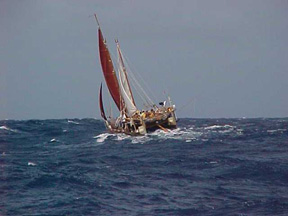 |
|
Dangers at Sea [Photos below by Makanani Attwood, from the voyage home from Rapanui: (1) Hokule'a sailing in windy seas; (2) Main sails brought in to prevent damage to the mast and rigging; (3) Hokule'a hidden behind a large swell.]
His nephew Rata eventually destroyed six of these eight dangers of the sea, so that today, only two, long-wave and short-wave, indestructible elements of the ocean, remain to challenge voyagers. The most potent danger faced by the modern-day voyager are high winds and seas, which could flood the hulls; capsize the canoe; break the mast, boom, or spare; or break the hulls apart. Careful storm sailing procedures are designed to prevent these mishaps from occurring. In the event of heavy weather, the following procedures are adopted by the Hokule'a crew: The sails may be partially or fully triced (closed); this is usually done prior to a squall. The sails may be lowered and changed, with smaller storm sails replacing larger sails. The smaller sails reduce the stress on the mast, spar, and boom, making it less likely that they will break. Some dangers associated with storms include: (1) capsizing; (2) breaking apart; (3) flooding; (4) crew members being washed overboard. Preventive procedures include the following: --To prevent capsizing, run downwind with the storm sail on the forward mast; adjust the distribution of weight on board the canoe for greater stability; and keep water out of the hulls by constantly bailing or pumping. --To prevent breaking apart, use rope collars to reinforce the lashings of the hull to the 'iako. The weak points of the canoe are where the wae are secured to the hull.
--To prevent crew members from being washed overboard, put on safety harnesses and secure them to the canoe. Life preservers should be worn. Other dangers include fire, man overboard, and serious injury or illness. A medical doctor is usually included among the crew to handle medical problems or emergencies. Crew safety is the highest priority. The crew is screened for good health, physical conditioning, and the ability to swim and stay afloat in the open ocean. The crew is trained to handle the canoe in rough ocean conditions, and the canoe is stocked with s afety equipment, including water-pumps, fire extinguishers, life jackets, safety harnesses and nets, a man-overboard float tethered to the stern of the canoe, and equipment to give the canoe's position in an emergency (GPS, Argos, EPIRB). Radio equipment allows communication with an escort boat or land stations. Two experiences during the 1985-87 Voyage of Rediscovery illustrate life-threatening situations and how they are handled. While sailing from Aotearoa to Tonga, a crew member fell overboard in the night when his safety harness broke while he was hanging ov er the side of the canoe to use the bathroom. Luckily navigator Nainoa Thompson saw his hat float by and sounded the alarm. Part of the crew scrambled to stop the canoe by letting the wind out of the sails; the others threw in the man-overboard float; Tho mpson went out on a surfboard to retrieve the crew member. On the voyage home in 1987, a crew member developed a skin infection; as he was allergic to penicillin and none of the other medicines on the canoe worked to stop the infection, the captain finall y had to radio for help and the injured crew member was taken off the canoe by the U.S. Navy. In 1995, a crew member on board Hawai'iloa's escort boat Kama Hele was injured while cutting up a fish the escort boat had caught. While the injury was not serious, he was medivaced off the boat by the Coast Guard since the crew did not want to risk infec tion of the wound on the 4 week voyage to Tahiti. |
 The ancient voyagers faced various dangers when they ventured out to sea in their canoes. The Tahitian story of the voyager Tumu-nui, king of Tahiti, lists eight dangers: isolated-coral-rock, sea-monster, long-wave, short-wave, fish-shoal, animal-with-bur ning-flesh, crane-empowered-by-Ta'aroa, and giant-clam-opening-at-the-horizon.
The ancient voyagers faced various dangers when they ventured out to sea in their canoes. The Tahitian story of the voyager Tumu-nui, king of Tahiti, lists eight dangers: isolated-coral-rock, sea-monster, long-wave, short-wave, fish-shoal, animal-with-bur ning-flesh, crane-empowered-by-Ta'aroa, and giant-clam-opening-at-the-horizon.
 --To prevent flooding, keep the hulls pumped, especially the front and back compartments of the hulls; keep hatch covers secured and tied down; monitor water levels in all compartments.
--To prevent flooding, keep the hulls pumped, especially the front and back compartments of the hulls; keep hatch covers secured and tied down; monitor water levels in all compartments.